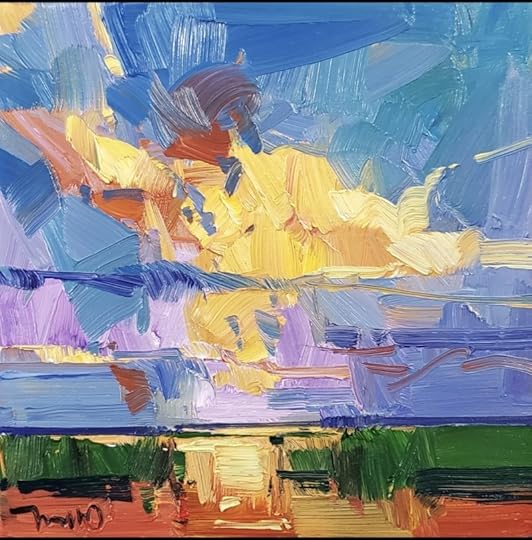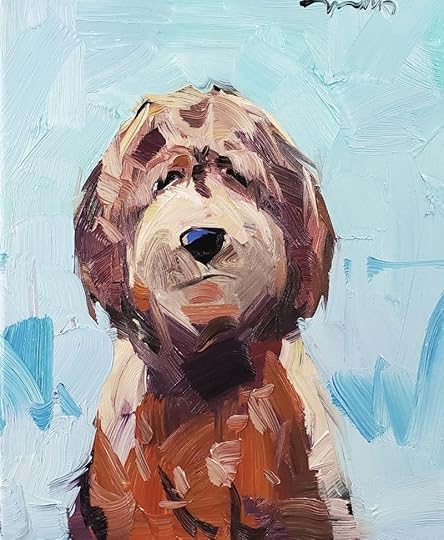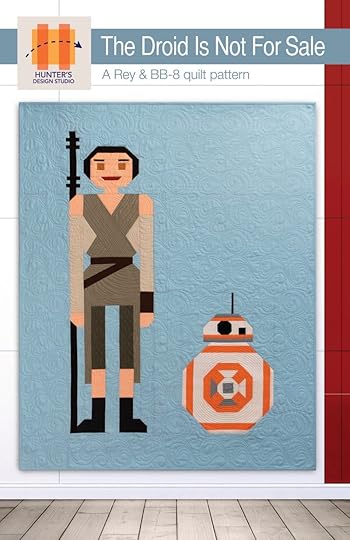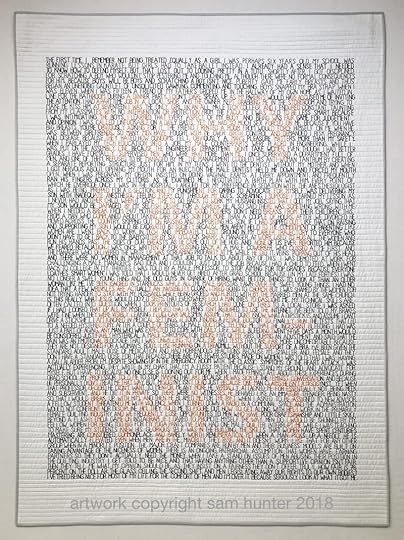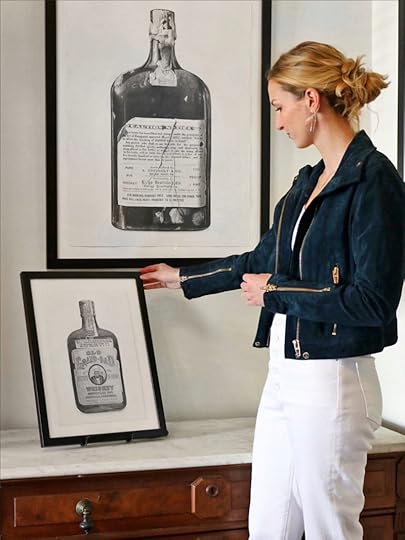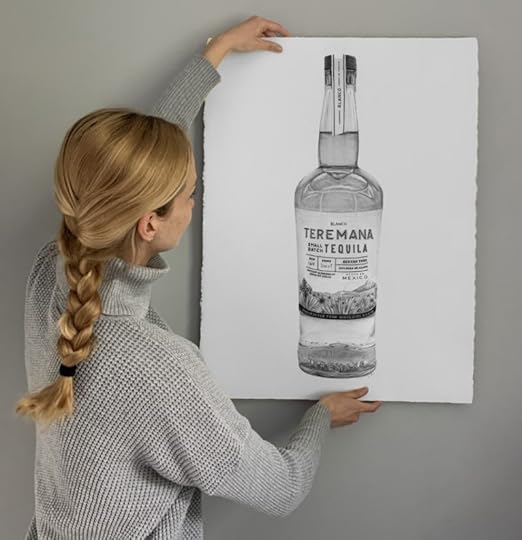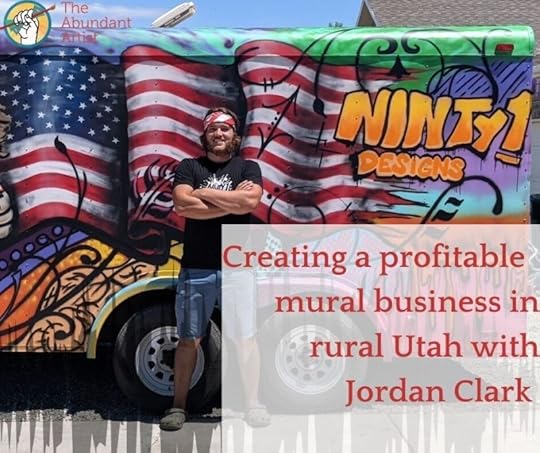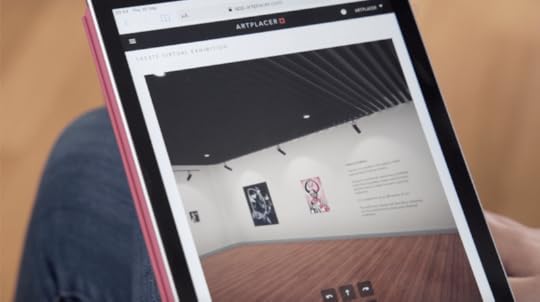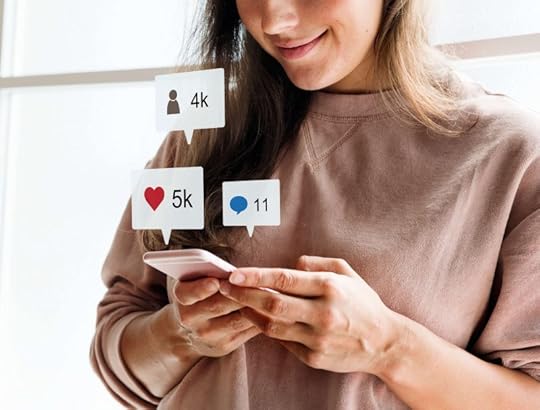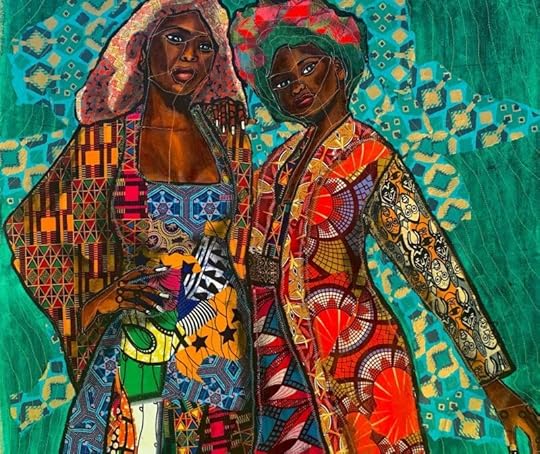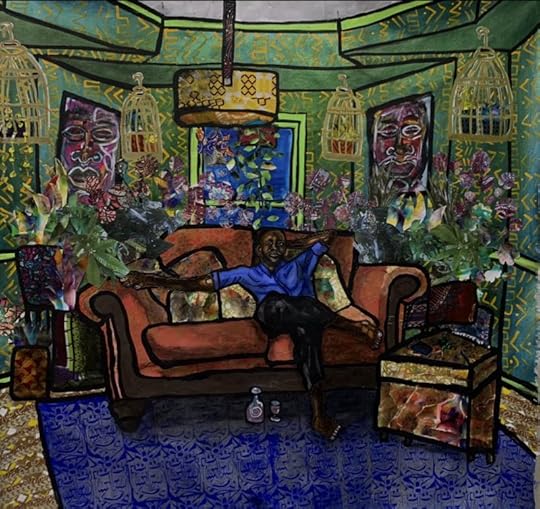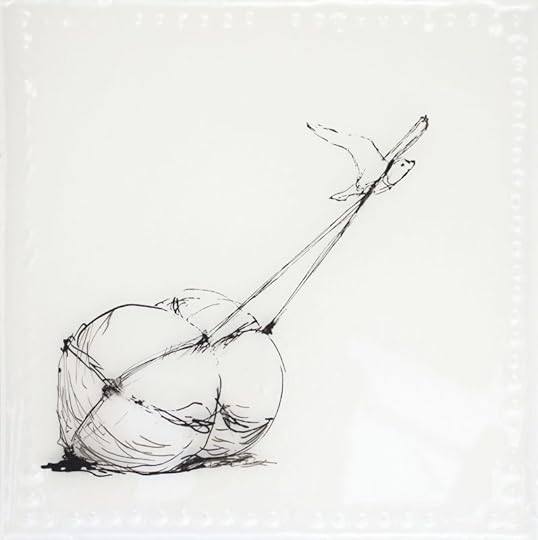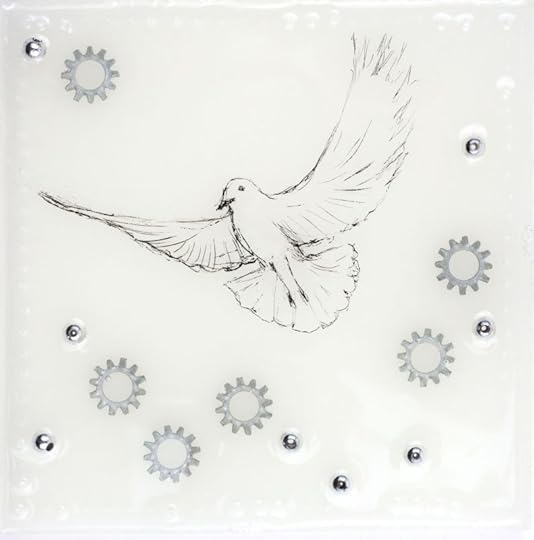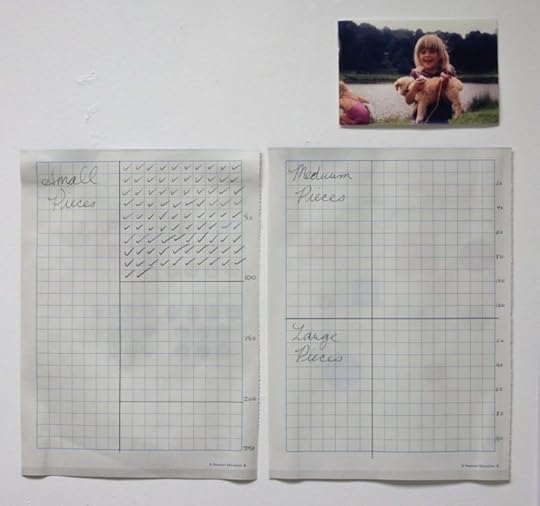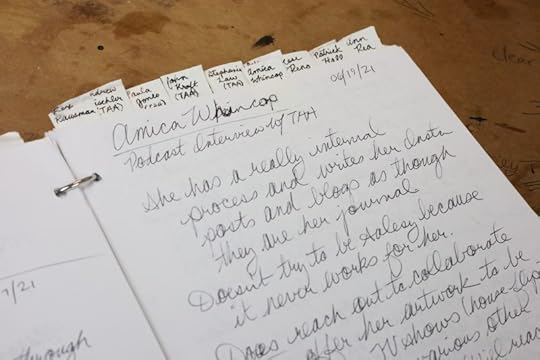Cory Huff's Blog: The Abundant Artist Goodreads blog, page 6
April 26, 2022
How can artists benefit from NFT?
Non-fungible tokens, more commonly known as NFTs, have revolutionized the way we view content ownership, bringing art into the digital age.
The NFT market platform OpenSea has been valued at a staggering $13 billion and the past year alone has seen the trade of around 28.6 million wallets. The NFT market place is booming, making it a perfect time and place for artists to start creating digital content and get in on the boom.
But what’s in it for artists? Although the NFT market may, at first glance, seem scary, complicated and intended for the benefit of collectors and speculators, this is not the case at all! NFTs open the door for artists to trade their art on a global scale with greater autonomy, lower barriers for entry, and increased monetary benefits.
This article will explain how artists can benefit from creating NFTs, but first…
What is an NFT?
NFTs are unique digital assets that can be traded on the blockchain. Unlike fungible tokens (cash or cryptocurrency), NFTs are one of a kind and cannot be swapped, since there is only one version of each asset in existence. NFTs can be art, photos, songs – anything which can be a digital file and stored on the internet.
As the blockchain makes it easy to verify ownership of an NFT, these assets have become an extremely useful way for artists, influencers, and musicians to sell versions of their work to a large base of consumers.
Additionally, the NFT marketplace can be seen as an evolution of the traditional art marketplace, eliminating all that can be seen as wrong with the traditional art marketplace and shifting the balance of power to benefit artists and creators. For example, allowing artists greater access to a global market, transparency with deals, and royalties to artists on all their creations and resales.
So what are the benefits of NFTs for artists?
Increased accessibilityAnyone is able to create, buy and sell NFTs through online platforms. This means low barriers for entry to allow aspiring artists to bring their art to a marketplace. Artists can create and sell their own work on their own terms to a huge and ever increasing number of buyers, with transactions made in a matter of seconds. NFTs are quick to make, quick to sell, in demand, and can be made from the comfort of your own home!
Global marketSince the NFT marketplace exists on online platforms, it is easy to access buyers, sellers and creators worldwide. Artists’ work is now able to cross global borders and be traded with ease. Additionally, fees such as shipping fees are avoided as the content exists online and can be traded with just a few keystrokes, making the process cheaper and virtually hassle-free in comparison to the hoops an artist has to jump through to sell their work via a traditional gallery.
OwnershipSpeaking of galleries, artists gain greater control and autonomy over their own work. Artists can make, display and sell whatever they want and don’t have to depend on a gallery or museum for backing, management or bringing clients in. In addition, further costs of displaying in galleries are avoided as artists work for themselves on their own terms.
Furthermore, NFT marketplaces offer automatic royalties and continued ties to the resale of works on the secondary market for artists. In the traditional market, once a piece is sold, the artist is no longer set to earn off that piece, and that includes any profits the piece could gain if the artist becomes more popular. However, with NFTs, the artist is entitled to a percentage of future sales of works (usually 10%-20%)! Artists not only retain ownership from being the creator of the works but continue to benefit monetarily.
SecurityThe connection of NFT marketplaces to the blockchain makes forgeries impossible as the blockchain provides a non-fungible record of authenticity. The NFT market is, on the whole, a much more regulated marketplace than the traditional art market which lacks transparency. In the NFT market, the artists can take control of the sales of their own art directly.
Steps to ensure your safety online can include: setting up a crypto wallet, using a strong password and a password manager, keeping your information private by securely storing your crypto wallet private keys and recovery phrases, and making sure your computer has up-to-date and comprehensive anti-virus software to protect you, your device, and your information against scams and cyber-attacks.
For peace of mind and ease, artists can also go through an NFT agency to avoid scams and other issues that newcomers in the market might be unaware of.
——————————————————————————————————–
These are just a few of the ways artists are set to benefit from the NFT market. Now is the time to start moving to digital. For more advise on how to begin your journey into the metaverse, visit Fracas Digital.
The post How can artists benefit from NFT? appeared first on Online Marketing for Artists.
April 5, 2022
What it’s like to sell 100,000 paintings with Jose Trujillo | TAA Podcast Season 5, Episode 6
Welcome to season five, episode six of The Abundant Artist, the show that dispels the myth of ‘the starving artist’ and shares how you can live an abundant life as an artist and make a living from your talent one interview at a time.
This week, Cory welcomes Jose Trujillo to the podcast! Jose is an impressionist painter that is one-of-a-kind in that he has been selling his art on eBay for over 10 years and has sold over 100,000 original art pieces online. Considered a modern Monet, Jose’s art has been described as “dream-like,” fast-paced, musical, and a “fantasy of colors.”
Jose shares both the highlights and the lowlights with his experiences of selling his artwork on eBay, how he keeps up with selling only original paintings online, his personal approach to painting, his journey and discovery with impressionist painting, and his unique philosophy on “finding the gems in the volume.”
In this episode:
[:30] Cory welcomes Jose Trujillo to the podcast!
[:47] Cory reads a quote about Jose on his website.
[1:28] Jose shares his experiences with selling his art on eBay for the last 10 years.
[5:22] Why does Jose consider himself “not known” in the art world even though he’s sold over 100,000 art pieces in the last 10‒12 years?
[7:10] Jose shares about his 4,000 square foot art studio space and his team behind the scenes.
[9:56] Why and how Jose only sells original artwork, and the system he created to keep up with his eBay sales.
[12:25] Where does Jose’s work ethic come from?
[14:41] Why Jose and his wife opened a clothing shop.
[16:14] When and why did Jose begin to sell his art on Craigslist?
[20:21] Jose shares his thoughts on Cory’s theory on whether or not impressionist artists are more willing to approach different ways of selling.
[23:22] How and why Jose learned how to paint and why impressionism, in particular, interested him.
[31:22] When did Jose begin to paint? How did he initially start practicing?
[33:38] Jose’s philosophy on “finding the gems in the volume” regarding art.
[35:22] What Jose’s schedule looks like now vs. earlier on in his career.
[36:16] Jose explains the quote on his website, “To see without the interruption of thought.”
[40:30] How Jose feels about his current work/life schedule.
[42:00] About Jose’s regular gratitude practice and how it helps him with his art.
[45:30] Cory thanks Jose for joining the podcast.
Mentioned in this episode:
Jose Trujillo Art
Jose Trujillo on eBay
Jose Trujillo’s Youtube
Video of how Jose created his messaging on Craigslist
Ugly Delicious (Netflix Series)
About the guest:
 Jose Trujillo was born in Guadalajara, Mexico in 1982, and moved to the US with his family when he was nine-years-old. He currently lives in Tucson, Arizona with his wife and son. Jose is a self-taught artist, who became interested in light, color, and motion at a very young age. As a young artist, he began visiting museums and studying the paintings of the old masters, finding that he was drawn to the Impressionist’s “blurry” view of the world. “Observing the color and style of these paintings transformed how I looked at my world. Once I saw the depth of color in the Impressionist’s view of the sky, I was hooked. After viewing the Impressionist artwork, I was unable to view the majestic skies of Arizona without spending hours contemplating their beauty,” says Jose.
Jose Trujillo was born in Guadalajara, Mexico in 1982, and moved to the US with his family when he was nine-years-old. He currently lives in Tucson, Arizona with his wife and son. Jose is a self-taught artist, who became interested in light, color, and motion at a very young age. As a young artist, he began visiting museums and studying the paintings of the old masters, finding that he was drawn to the Impressionist’s “blurry” view of the world. “Observing the color and style of these paintings transformed how I looked at my world. Once I saw the depth of color in the Impressionist’s view of the sky, I was hooked. After viewing the Impressionist artwork, I was unable to view the majestic skies of Arizona without spending hours contemplating their beauty,” says Jose.
The post What it’s like to sell 100,000 paintings with Jose Trujillo | TAA Podcast Season 5, Episode 6 appeared first on Online Marketing for Artists.
March 16, 2022
The Politics of Fiber Art with Sam Hunter | TAA Podcast Season 5, Episode 5
Welcome to season five, episode five of The Abundant Artist, the show that dispels the myth of ‘the starving artist’ and shares how you can live an abundant life as an artist and make a living from your talent one interview at a time.
Oregon-based fiber artist and quilt designer, Sam Hunter, joins the podcast today to discuss her journey as a full-time artist, the important messages she stands behind, and powerful advice to those looking to go full-time but not burn out.
Sam is not afraid to put her voice out there and speak her mind! In this episode, she speaks about the importance of knowing your worth as an artist, receiving fair compensation for your work, equality in the arts (and tech!), how to overcome decision fatigue and “the loser hangover,” hiring for your team and making money as a fiber artist. Don’t miss out!
In this episode:
[:30] How Sam would describe her art.
[1:46] What fiber art is, the type of fiber art Sam does, and what guided her path as an artist.
[5:35] Sam discusses the prejudices towards women who sew and quilt.
[8:53] The statements that Sam makes with her art pieces and why she supports women in tech.
[14:52] The one piece of advice that Sam would give to all artists.
[17:14] How Sam makes a living as an artist.
[19:05] How many quilt patterns has Sam released?
[19:55] Sam shares about the process of writing her quilting pattern book.
[22:08] How to sell and make money from quilting patterns.
[24:22] How COVID has impacted Sam’s business.
[25:55] Why Sam is considering no longer doing lectures.
[27:28] Sam shares her perspective on paying artists what they deserve and how purchasing art is a luxury; not a right or a need.
[34:45] How Sam expanded her team.
[37:53] Decision fatigue and why it is so important to delegate as a creative.
[42:14] “The loser hangover” and how to combat it.
[47:24] How to know who to hire for your team.
[52:00] The biggest challenge of being an artist in 2022.
[53:56] Cory thanks Sam for joining the podcast and Sam shares where to follow up with her and her art online.
Mentioned in This Episode:
Sam Hunter
ChickTech
Black Girls Code
Quilt Talk, by Sam Hunter
About the guest:
 Sam Hunter is a Portland, Oregon-based fiber artist and quilt pattern designer, and the “Chief Everything Officer” at Hunter’s Design Studio. Sam started sewing when she was 7 and quilting in her 20’s, and teaching quilting shortly thereafter. She holds an MFA in Fiber Arts. Sam also teaches business classes and mentor colleagues in her industry.
Sam Hunter is a Portland, Oregon-based fiber artist and quilt pattern designer, and the “Chief Everything Officer” at Hunter’s Design Studio. Sam started sewing when she was 7 and quilting in her 20’s, and teaching quilting shortly thereafter. She holds an MFA in Fiber Arts. Sam also teaches business classes and mentor colleagues in her industry.
The post The Politics of Fiber Art with Sam Hunter | TAA Podcast Season 5, Episode 5 appeared first on Online Marketing for Artists.
March 7, 2022
The 5 Art Business Models
The more different things you try to do with your art business, the more complexity you introduce and the harder it will be to make a profit.
There are five essential ways that artists make money from their art. For most artists in the early stages of their careers, I recommend they pick one way and do that until they’re making enough money to live on.
The five art business models are:
Direct to collector original worksGallery salesPrints & reproductionsCommissionsLicensingI’ll explain real quick each model, and why doing two or more of these at a time makes everything harder.
Direct-to-collector is the most common way art is sold. It’s a broad category that includes selling from your website, an indoor or outdoor art fair, farmer’s market or studio visit. Most artists start out with direct sales and hope to move to gallery sales. Some artists choose to skip galleries because they can retain a higher percentage of their sales by doing it themselves, or because they don’t want to deal with galleries having exclusive rights to sell certain works.
Gallery sales are pretty straightforward. Most artists understand how this works. It’s a standard retail model on consignment, where the product is sold and the maker of the product gets 50% of the sale price (usually after the sale, rarely in advance). Many galleries require exclusivity, don’t want artists building relationships with the gallery’s collectors, and often they refuse to do things like offer reproductions or work with art that has been licensed.
Prints & reproductions can become the most complex way of selling art. When you sell an original it’s one item. With how easy it is to print things now, artists will often introduce infinite complexity into their business by offering 3-5 substrates and 3-5 different sizes of prints. Suddenly your collectors went from one choice for that painting to 25 choices. That also means your shipping became 25 times as complex, and your website inventory management also became 25 times as complex. Managing that complexity alongside selling original works is enough to stress out a lot of artists.
Commissions are seemingly straightforward, but artists get caught up in never-ending revisions, client hand-holding, and managing timelines. The truth is that when you start offering commissions, you’ve moved towards creating a service-based business and you have to decide in advance how much service you’re willing to offer, what you’re willing to compromise on, and how many revisions you’re willing to do. Switching back and forth between commissions and original art sales will often highlight the difference between making what feeds your soul and dealing with demanding and needy collectors. That dissonance is too much to bear for some artists and that’s ok.
Licensing is another world entirely. Giving companies the right to use your images on their mugs, cups, and calendars sounds like an easy way to make money, but licensing contracts are full of dense, complex legalese. You’ll also be asked to change a pattern or create something custom for the licensee. If you’re not experienced working in the corporate world, licensing can be a steep learning curve, and individual deals rarely bring much money. Licensing is a volume play that means you’ll need to focus a big chunk of your time to make a significant income.
In a social media post a few years ago, I wrote:
One artist is doing a TON of different things. She’s selling original pieces, and prints of those pieces. She’s also selling another line of art in a slightly different style. She has sold art to celebrities.
On top of that, she has two print licensing deals. She’s been featured in Target and on a famous TV show. She won a juried art show that brought her a lot of prestige.
Her business is complex, and busy.
And she’s not making enough money to get by.
This artist is essentially doing all five business models at the same time. Every day she’s switching contexts, remembering the details of complex deals, and dealing with collectors who have demanding expectations.
Even if that kind of switching sounds fun, struggling to get by financially definitely squeezes the fun out of it.
The post The 5 Art Business Models appeared first on Online Marketing for Artists.
February 24, 2022
Standing Out in the Crowd as a Hyperrealist Artist with Brie Hayden | TAA Podcast Season 5, Episode 4
Welcome to season five, episode four of The Abundant Artist, the show that dispels the myth of ‘the starving artist’ and shares how you can live an abundant life as an artist and make a living from your talent one interview at a time.
Joining the podcast today is American realism artist, Brie Hayden. Brie is based in Arlington, Virginia; just outside of DC. She is a self-described left-brained artist who is obsessed with detail and shading; leaning further in hyperrealism with every piece that she creates.
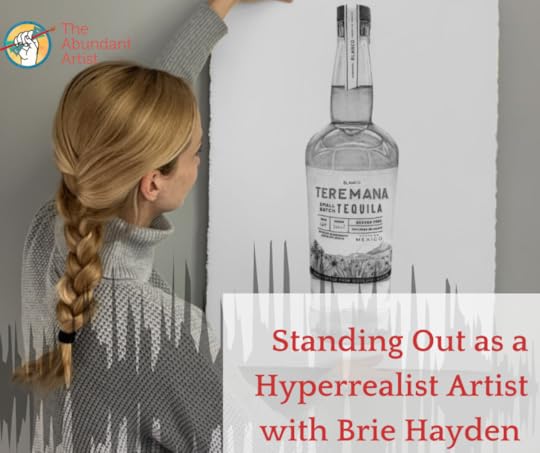
With her experience working from home during the pandemic; busking internationally in Melbourne, Australia; and gaining notoriety from Dwayne “the Rock” Johnson himself, Brie has a truly unique story of finding success in the art world. In this conversation, she shares her journey of going from 700 to 20,000 followers overnight, discovering herself as an artist, and marketing herself to an audience that connects with her work.
In this episode:
[:30] Where Brie Hayden is based.
[1:30] Brie shares about her busking in Melbourne, Australia.
[3:26] Is Brie a self-taught artist?
[4:19] Brie’s early days as an artist.
[7:34] How Brie’s career shifted with the pandemic.
[8:19] How Brie began to sell her art and some of her exciting early breakthroughs.
[15:00] How Brie’s time busking in Australia changed the way she operated as an artist.
[15:48] What it felt like to go from 700 to 20,000 followers overnight, and the doors that it opened for Brie’s career.
[16:52] How Brie describes her artistic style.
[17:15] How Brie takes on commissions and the timeline for her current waitlist.
[18:19] The motivation behind Brie’s current focus on alcohol bottles.
[20:00] The key differences between photography and hyper-realism.
[21:27] The beauty in ‘human error’ with regard to art.
[22:26] Why Brie describes herself as a ‘left brain artist’ and how this impacts her art process.
[25:56] Brie shares her joy for getting non-artists to appreciate art.
[27:00] What’s next for Brie?
[28:06] Does Brie sell prints of her work?
[28:36] Cory thanks Brie for joining the podcast.
Mentioned in this episode:
Brie Hayden
Amanda Palmer
Jackson Pollock
About the guest:
 Brie Hayden is an American realism artist from Virginia, who works mostly in graphite. She describes herself as a “left-brained artist,” obsessed with detail and shading. Brie’s drawing process becomes almost meditative for her, as she works to mimic the contours, light, and shadows she sees in her photo references. Her style continues to push further into hyperrealism, as she works to perfect her craft. “I work exclusively in mediums that I can tightly control, making no unintended marks. Constantly sharpening my pencils and working entirely freehand, I draw objects with often unnoticed or unappreciated details,” says Brie.
Brie Hayden is an American realism artist from Virginia, who works mostly in graphite. She describes herself as a “left-brained artist,” obsessed with detail and shading. Brie’s drawing process becomes almost meditative for her, as she works to mimic the contours, light, and shadows she sees in her photo references. Her style continues to push further into hyperrealism, as she works to perfect her craft. “I work exclusively in mediums that I can tightly control, making no unintended marks. Constantly sharpening my pencils and working entirely freehand, I draw objects with often unnoticed or unappreciated details,” says Brie.
The post Standing Out in the Crowd as a Hyperrealist Artist with Brie Hayden | TAA Podcast Season 5, Episode 4 appeared first on Online Marketing for Artists.
February 9, 2022
Creating a Profitable Mural Art Business in Rural Utah with Jordan Clark | TAA Podcast Season 5, Episode 3
Welcome to season five, episode three of The Abundant Artist, the show that dispels the myth of ‘the starving artist’ and shares how you can live an abundant life as an artist and make a living from your talent one interview at a time.
This week, your host, Cory Huff, is joined by Jordan Clark, a professional murals and signs artist based in Vernal, Utah; a small town with a population of approximately 15,000.
In this episode, Jordan shares what life is like as a mural artist (and the unique challenges that it brings), how he came to be a mural artist, the full process of creating a mural from scratch to completion, and his advice and insights on those looking to get started with murals themselves. Jordan also gives a look into the backend of his business, sharing what he has learned from online advertising, finding his audience, and creating an art business that generates over $150k a year with 4 employees.
 DinalandKey Takeaways:
DinalandKey Takeaways:[:31] Where Jordan Clark is based.
[3:24] The unique challenge that painting murals bring.
[4:43] How Jordan originally got into painting murals and his journey of how he has gotten to where he is today.
[10:59] How Jordan balanced his family, work, and painting murals.
[17:08] About a special mural Jordan painted for a friend and how his mural painting business began to snowball.
[19:00] Why Jordan hates the “starving artist” stereotype.
[20:50] How Jordan continued to grow his business in a small town by identifying his customer base.
[24:23] What Jordan learned from experimenting with online ads.
[30:35] What worked vs. what didn’t work with the advertising Jordan tested.
[32:18] Jordan’s thoughts on being commissioned to do political artwork.
[34:44] The audience that Jordan tries to target with his business and the process of how he creates artwork on a commission basis.
[36:13] Jordan’s main goal as a mural artist, his advice to those who also want to make a living as a mural artist, and about the biggest murals he has ever completed.
[38:08] The process of creating a mural.
[43:57] Jordan shares how mural painting is for everyone.
[46:45] Why you don’t need a ton of followers to create a business for yourself, create jobs, and support your community.
[48:00] What Jordan would do differently if he had to start over.
[49:14] Cory thanks Jordan for joining the podcast.
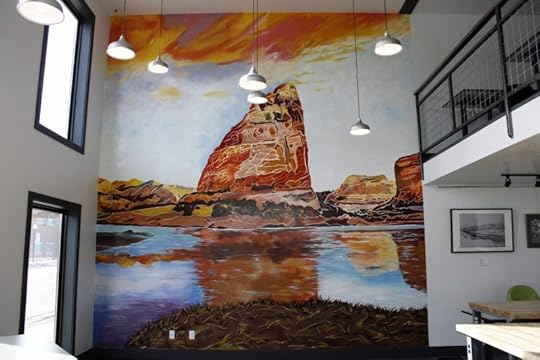 StramboatRockMentioned in this episode:
StramboatRockMentioned in this episode:Ninty1 Designs (Jordan Clark’s business)
Colossal Media
Overall Murals
 Jordan Clark, owner of Ninty1 Designs, was born and raised in Vernal, UT. He grew up drawing constantly, eventually found a love for painting in high school, and soon after sold his first painting. As he painted he progressively worked on larger canvases, which culminated in his first mural. He spent six years in the land survey industry (completed 10 murals during that time), and never would have guessed that during 2020, a year of hardships, shutdowns, and many other challenges due to a pandemic, he would transition to a full-time artist. Ninty1 Designs strives to bring color and brightness to all client projects. Thus far, the company has accomplished this goal for businesses and cities, which attracted tourism and brought joy to viewers. “We look forward to 2022 with a growing list of murals that we have planned to paint. We want to thank our clients and supporters, and cannot wait to bring art to a community near you!”, says Jordan.
Jordan Clark, owner of Ninty1 Designs, was born and raised in Vernal, UT. He grew up drawing constantly, eventually found a love for painting in high school, and soon after sold his first painting. As he painted he progressively worked on larger canvases, which culminated in his first mural. He spent six years in the land survey industry (completed 10 murals during that time), and never would have guessed that during 2020, a year of hardships, shutdowns, and many other challenges due to a pandemic, he would transition to a full-time artist. Ninty1 Designs strives to bring color and brightness to all client projects. Thus far, the company has accomplished this goal for businesses and cities, which attracted tourism and brought joy to viewers. “We look forward to 2022 with a growing list of murals that we have planned to paint. We want to thank our clients and supporters, and cannot wait to bring art to a community near you!”, says Jordan.
The post Creating a Profitable Mural Art Business in Rural Utah with Jordan Clark | TAA Podcast Season 5, Episode 3 appeared first on Online Marketing for Artists.
February 1, 2022
How to host a 3D show on your website and nail it
Over the past year, artists, galleries, and art fairs have merged their online and physical efforts. As shows return to the in-person format, it’s becoming clear that a hybrid (digital and offline) strategy is what’s working best for sales right now.
New, innovative opportunities have materialized such as online viewing rooms, 3D interactive shows, and Augmented Reality apps that allow collectors to see a piece in their home right on the spot. But, do these kinds of tools actually sell any art for artists?
We believe that 3D virtual exhibitions are making their way as an exciting tool to promote art online, engaging customers in an experience that they can re-visit several times while relaxing at home. The direct purchase options and the international reach online shows provide are allowing artists to expand their businesses.
Have you explored gallery apps that create online shows, but never really understood how to make the most out of them? Here you’ll learn how.
Make your website the center stageYour virtual event can be hosted on your website, luring recurrent and new collectors to your online space. This kind of invitation into your virtual environment can be quite promising for people that follow your journey. It’s like a sneak peek into your studio life.
An online show will increase your website visits, creating new sales opportunities. Make sure to have high-quality images of your pieces, thorough descriptions, and additional elements that will catch your visitor’s attention like a short statement about the curation or about your new pieces. As Arty’s “Art collecting 2021” report states, collectors see their online activities as inseparable from and essential to their experience of the art market.
Artist Tim Muddiman from the UK told us about his solo show ‘The Ones Who Slept There’ (July 24 – August 31, 2021). The exhibition took center stage on his homepage, and he was able to add screenshots with relevant links to guide people to navigate and experience the show in full.
He had also been working on a playlist for about a year, so he encouraged visitors to play that music as they viewed and explored the work. “It was a true, real experience transferred to the virtual world.”
His first solo show in summer 2021 was canceled at the last minute due to gallery staff getting COVID, so he was left high and dry for a body of work he’d been working on for the previous six months. He had seen the online exhibitions on the ArtPlacer socials, so quickly moved his curated show there.
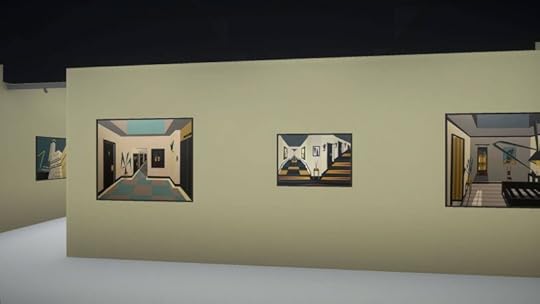 The Ones Who Slept There, Tim Muddiman
The Ones Who Slept There, Tim MuddimanGain international reach
Long distances are no longer a barrier to promote your body of work. If you already have an international following, people that weren’t able to visit your shows before, can now appreciate your work online. If you are just beginning to explore international sales, virtual events will help you widen your audience and have a new revenue stream.
Exhibitions can be showcased to a global audience rather than only national, and for many artists this has proven to be incredibly powerful and successful.
What are the benefits of hosting a hybrid show?Virtual replicas of IRL shows work wonders for people wanting to take another look at the pieces. And this repeated viewing of the display, helps collectors develop an appreciation and a better understanding of the artists’ work.
Visitors can talk about the in-person show by describing the experience, but also complementing it with visuals. They can invite their partner and friends to enter the online show, at any time.
Most gallery software allow artists to add “more info” buttons that link to a specific part of their website, and video links inside the show to captivate collectors. In addition, ArtPlacer offers a downloadable PDF brochure and Augmented Reality interaction with the piece.
By re-visiting the pieces and interacting with them online, collectors are more prone to inquiring or buying. And in the long term, this builds up recognition and more sales.
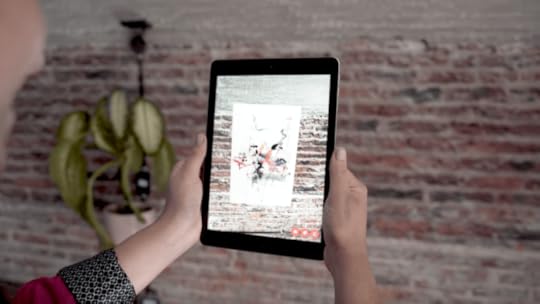 ArtPlacer AR feature, Artwork by Vicky Barranguet
ArtPlacer AR feature, Artwork by Vicky Barranguet
Online shows can act as a channel for people to meet new artists. A collector may see the virtual exhibition first, and afterward decide to visit the physical show. After hosting his two online shows, artist Tim Muddiman mentions, “Some collectors got in touch and came to my studio to view the work in person after seeing it digitally. Having virtual exhibitions is a fantastic tool to further showcase new collections or bodies of work to new and old online communities.”
Get direct purchasesNowadays, collectors expect visible prices on artworks. For next-generation collectors (people that started buying art over the past four years), not having a visible price becomes a roadblock to purchasing art online. They want the buying process to be frictionless and secure.
This segment of collectors also prefers to find new artists on their phones and are more likely to purchase art from their mobile devices. This leads us to say that one-click “buy” buttons are a requirement in order to grow sales, and will soon be the standard of the industry.
The artworks inside your online shows must have “buy” buttons with direct links to purchase. They are ideal for the new generation of consumers and for old collectors that have increasingly adopted the online world. Be certain to have your e-commerce up and running for visitors to seamlessly purchase your art using a credit card.
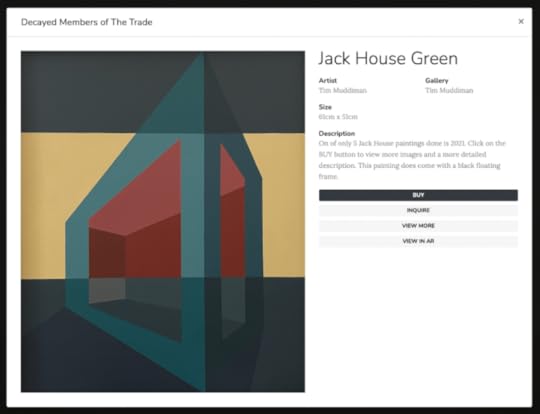 Buy button, Decayed Members of the Trade, Tim MuddimanBuild momentum to maximize exposure
Buy button, Decayed Members of the Trade, Tim MuddimanBuild momentum to maximize exposureSo, you start using a virtual gallery software and thoroughly curate your first show. What should you do next? Invest time in building an online strategy.
Start with a pre-launch campaign using social media. You can create a Facebook event, and announce that a new show is coming. Build up your audience with day-by-day insights until the launch.
Another highly effective way to reach your contacts is through email marketing. Send one or two emails weeks before the show to arouse curiosity. Send another one on the morning of the opening to share the big news.
A good piece of advice is to create a visual piece that strikes your audience’s attention. Additionally, you can make a video or go live on Instagram. Give information about you and the process that led you to create this show. Storytelling is a big plus to engage your audience.
Once the show opens, share the news in every possible channel: Facebook, Instagram, YouTube, WhatsApp, Telegram, you name it. Publish high-quality images of your work, send a press outreach, and invite everyone to access your new project. Online shows can be accessed from any device, 24/7; so as long as your collectors have an internet connection, they will be able to enjoy your show.
If you start thinking about digital as an integral component of your strategy and start building a strong online presence all-year long, your recognition and business will grow.
New tools, new strategiesHybrid thinking can only enrich an artist’s career and offer more chances of promotion.
Artist Muddiman mentions the importance of talking and bonding over a nice chat with collectors. “I like to meet and speak with people interested in my art, and in-person exhibitions or art fairs are a valuable way to do this. I think for the modern artist doing both online and offline shows, at a manageable time, is very important, expressive and thoroughly enjoyable.”
Virtual exhibitions diversify the access to the art world: independent artists now have a tool where they can showcase themselves in a professional manner.
They can connect with their collectors via a rich experience, offering them the chance to interact and re-visit their work. They can expand their business by meeting new collectors, and gaining (or growing) their international following. In addition, direct purchase links and on-platform transactions accelerate artist’s sales.
It’s time to reflect on everything affecting artist success and start throwing new ideas into the mix. Online shows are here to stay and you should make the most out of them.
ArtPlacer has generously offered a discount for TAA readers. Go to https://www.artplacer.com/signup and enter THEABUNDANTARTIST promo code for 30% at checkout.
The post How to host a 3D show on your website and nail it appeared first on Online Marketing for Artists.
January 26, 2022
Zsudayka Nzinga on Serendipity in Art, Opening an Art Gallery, and Celebrating Black Culture | TAA Podcast Season 5, Episode 2
Welcome to season five, episode two of The Abundant Artist, the show that dispels the myth of the starving artist and shares how you can live an abundant life as an artist and make a living from your talent one interview at a time.
In this episode, Cory is joined by Zsudayka Nzinga; a multi-faceted person and artist with an emphasis on African American figurative work. As a mixed media artist and designer, Zsudayka’s aim is to capture and archive the history and culture of Black Americans. Her work seeks to normalize the day-to-day of Black Americans and celebrate culture while also highlighting moments shared by all humans.
Zsudayka shares her journey and self-discovery as an artist; her process with commissions, selling her artwork online, and marketing through social media; her advice on promoting your artwork and converting fans of your work into paying customers; how she navigates politics and controversy as an artist; how she came to open her own art gallery, and the inspiration behind the pieces she creates.
In this episode:
[:30] Cory welcomes Zsudayka Terrell to the podcast!
[1:22] Zsudayka shares about her background and how she has become the multifaceted
person and artist that she is today.
[3:59] How Zsudayka taught herself art.
[7:24] Zsudayka shares about her transition from journalist to artist.
[11:57] Does Zsudayka believe that serendipity in an art piece happens more often for
self-taught artists than those who are classically trained?
[13:57] Does Zsudayka feel she has more freedom with her art than those who have
been through classical training?
[15:45] The value in both classical training and being self-taught.
[17:25] Why Zsudayka chose to move to a predominantly black neighborhood in DC and
open an art gallery.
[24:02] How Zsudayka navigates politics and controversy as an artist.
[31:09] Zsudayka describes the art that she is doing now, the inspiration behind them,
and the messages she wants to share through her art.
[34:55] Zsudayka’s process with commissions, selling her artwork online, and marketing
through social media.
[41:03] Why it is so important to foster relationships as you’re marketing and selling your
artwork.
[43:46] How Zsudayka fosters relationships in her business to help promote her art.
[47:34] Cory thanks Zsudayka for joining the podcast and sharing her wisdom.
Mentioned in This Episode:
TerrellArtsDC.com
Zsudayka Terrell’s Instagram @zsudayka
Zsudayka Terrell’s Linktree
How to Sell Your Art Online: Live a Successful Creative Life on Your Own Terms, by Cory Huff
About the Guest:
 Zsudayka Nzinga is a fine artist, curator and educator from Denver, CO living in Washington, DC. Her work is largely focused on mixed media portraiture of American life including themes of motherhood and culture. Her pieces explore patterns and textures using acrylic, oil, decorative and hand dyed paper, fabric, thread and ink on canvas. She also makes jewelry using silver, wood, resin and precious stones. She is a proud mother of 3 children and wife to artist, James Terrell.
Zsudayka Nzinga is a fine artist, curator and educator from Denver, CO living in Washington, DC. Her work is largely focused on mixed media portraiture of American life including themes of motherhood and culture. Her pieces explore patterns and textures using acrylic, oil, decorative and hand dyed paper, fabric, thread and ink on canvas. She also makes jewelry using silver, wood, resin and precious stones. She is a proud mother of 3 children and wife to artist, James Terrell.
The post Zsudayka Nzinga on Serendipity in Art, Opening an Art Gallery, and Celebrating Black Culture | TAA Podcast Season 5, Episode 2 appeared first on Online Marketing for Artists.
January 25, 2022
Artist Studio Visits: A Guide to Selling More Art
An artist recently asked me for some advice on how to sell more of her art. After going back and forth via email several times, I suggested that she try some artist studio visits. Her response:
“This may sound stupid, but how do I make anyone interested in that? Please understand, I am an introvert. Yes, I can make myself pretend to be outgoing, but it’s just an act. I guess the other part of this is I need to understand why anyone would even want to see a studio? I’m not trying to be silly, I just understand it. It’s a place where I work. I’m not trying to be difficult, but as I don’t understand the appeal, what would I say or do if someone wanted to see my studio.”
Let’s talk about it.
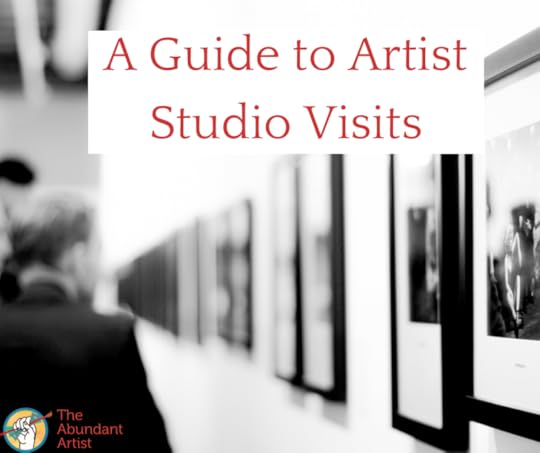
In simple terms, an artist studio visit is nothing more than fans or collectors going to an artist’s studio, seeing their work, and talking to the artist.
In-person visits. There’s a wide variety of ways in-person visits can happen. The most common ones include open studio tours hosted by arts organizations, open invites from artists to their general fans, or invite-only one-to-one visits. It often also includes watching the artist make work.
Virtual visits have been rising in popularity and exploded in 2020. Whether its direct Facetime, Zoom, or some other tool, there are many ways to video stream a tour of your studio.
Why would anyone want to visit an artist’s studio?Curiosity and entertainment. Many people love to see an artist’s studio because it’s inherently interesting. Many artists forget that making art is magical. It might seem normal to you, but it’s definitely not to the average person. It’s fascinating to watch artists make their work. You don’t have to put on a show, but just welcoming people in while you work and showing them around is enough.
To feel good about making a purchase. Some collectors just want a personal connection with the artists they collect. They want to hear your stories, your voice, and your worldview. They want to know the mind and background that created the work that they love.
How to host a studio visitShow your work. Hang your work in your studio. If you don’t have a big studio, that’s ok! Host a virtual visit of your home art making space or hang your work in your living room and invite people by appointment. Whatever you choose to do, make it about showing your work – the finished pieces and the works in progress. Give your visitors time to connect with you and ask questions.
Be welcoming. Put out some snacks and drinks (even if it’s just water). Refreshments always make people feel like they can linger, and you want people to linger over your work. Smile and welcome people, make polite conversation and ask them questions about themselves and what brings them to your studio. Some artists will make small cards for themselves with notes on what to talk about and ask.
Set a time and invite everyone in advance. If you’re not working with an arts org, simply set a time and let your people know you’re doing it. You can email 10-20 friends for a practice session if you don’t have a mailing list. If you do, email your list. Be sure to also post on social media like Instagram. You can even try submitting to local event calendars like your news orgs, Facebook groups, Meetup.com and other websites. Try to schedule it at least two weeks in advance, and as long as 2-3 months if you expect a large crowd.
Personalized 1:1 visits by appointment. Scared of illness or just don’t want a lot of people in your space? Try doing prescheduled 1:1 visits. These work especially well for regular collectors or people with very limited time. Schedule 30-60 minutes with 10 minutes of recovery time between sessions. 1:1 sessions often lead to deep discussion and bigger sales opportunities, but they are a lot more work.
Ask for emails. Be sure to put out a guest book and if people are interested in your work, have them register for your email list. Read more about email marketing for artists.
Ask for the sale. If someone is excited about your work, be sure to let them know its for sale, and ask them if they’d like to take it home. Read more about basic sales skills for artists.
Follow up. If someone says they’re interested, or if they sign up for your mailing list, be sure to follow up with them after the open house and ask them if they would like to purchase any of your work.
Studio visits are a regular part of most artists’ sales process. Connecting with your collectors is the best way to build a long-term sales relationship with them. If you have any additional guidance on how you make your studio visits great, please share in the comments.
The post Artist Studio Visits: A Guide to Selling More Art appeared first on Online Marketing for Artists.
January 18, 2022
How I Designed My Own Self Guided MFA
Sometimes it’s hard to admit when you have a desperate need for something big. You know deep down it’s going to require a lot of change to achieve. That can be scary.
In the middle of Covid, I had a really honest look at my life. I had four young kids, a great art school education, a teaching certificate, and a pretty good creative practice all things considered. But I wanted more. I wanted to have the deep creative satisfaction I found during my BFA. I wanted to feel fulfilled to the core, knowing I was making the art I really wanted to make, that I knew I had to make.
For the first time, I admitted if I had done an MFA instead of that teaching conversion course I would be farther along in getting what I really wanted out of life.
So what to do about it? Again, I had four little kids. Ages 4, 6, 7 and 9 in fact. I was a stay at home mom and my kids needed me like salamanders need water. A real, accredited MFA would be logistically impossible and financially inadvisable.
But I still had this burning need, and having admitted it to myself I had to do something about it or it would eat me alive.
So how could I get what I wanted? I had heard about art consultants that you could pay to give you a critique. Could I employ them? I decided to call a friend of mine who had an MFA to ask her about it.
Thankfully, this friend was more than happy to answer my questions. She told me the most useful elements of her MFA were the camaraderie between her and the other graduate students and the time to make the work. It was all independent study – no assignments. Overall she said it was a useful experience, but hugely overpriced considering how difficult it is to get a professorship off the back of it.
I proposed an idea I had – what if I made my own self guided MFA course? What if I gave myself the assignment to create 50 small pieces, 30 medium sized pieces and 15 large pieces? Once I had made enough work to be fairly sure of a direction, I could employ art consultants to review my work. These could be professors at a local university, people I approached from the local art museum, or even someone working in a gallery I admired. I could pay them well for their time and it would still be vastly cheaper than an actual MFA. I would have to work out some way to get the camaraderie I needed – perhaps start a critique group with some local artists?
She thought it was a great idea! With this positive feedback, I immediately got to work.
In the run up to this, I had worked hard to establish a creative practice by getting childcare help from my parents and husband. When my kids were sleeping well through the night, I could work a little in the evenings too, but that wasn’t dependable. All those pockets of time added up to about 6-7 hours a week. My studio was in the basement of our house so I could get to it easily.
But how was I going to structure my use of that time?
Key Components
I thought it was really important that I did not set any time requirements or deadlines. For other people, this would be key, but I had found, through experience, that my children’s needs were like shifting sands in a sandstorm. A storm could blow up out of nowhere and I would have to drop everything to attend to them until I had it figured out. Deadlines would cause way too much frustration. Instead, I made it a requirement that I sustain a feeling of momentum.
Now, this is a really important concept. Momentum is the feeling of being in forward motion. In order to preserve momentum, I needed to keep good records of what I had done. This would act as a “scoreboard” that would show me how much I had achieved. (I read about this in The 12 week Year, which I highly recommend.) One of the first things I did was create a grid I could put on my studio wall so I could tick off the artworks as I made them.
Another thing you need for momentum is to be really clear on what you want. I knew from the depths of my soul I wanted to achieve a level of depth in my creative practice I hadn’t felt since art school. I also knew I had a tendency to spend too much time on the “business” side of getting my artwork out in the world, AND a tendency to get distracted by what everyone thought about it! I decided to focus ONLY on creating the artwork until I got a bit more centered within myself.
Accountability is also really key for driving momentum. That sinking feeling in my stomach from knowing I wasn’t leading the life I wanted made me feel accountable to myself. I knew this was my life to live so I had better get busy. But just to be sure, I told all my closest friends what I was doing.
Starting Studio Work
So I began! I started by making lots of really small pieces. To my joy, I rapidly became addicted to ticking off the squares on my grid as I made new small artworks. It made me feel so good! And even if you hate the piece you made, you still get to tick off a square!
Quickly I was in the thick of it again, making and making, the work pouring out of me like honey. Within about three months I had already made 50 small pieces and decided to raise the number to 100 because I was making such good progress.
Camaraderie
Around this time I found out about a “Creative Clarity Cohort” that a local artist coach named Court McKracken was starting. It was small group coaching through a series of sessions in which you take a deep look at why you make the work you do and the passion, intention, and purpose behind it. It sounded ideal!
This group was fabulous! Within it I had a deep dive into what I needed in order to create, why I make the work I make and how to proceed forward with purpose. Court was fantastic! I highly recommend her book Art Nurture for more helpful guidance in supporting your creative practice.
Through the group I made a lovely friend and we started meeting on zoom once every two weeks to chat about our studio practice. I also went to an art school reunion and renewed an old friendship from that! In addition I reached out to another old friend from art school and we began chatting regularly!
With each of these friendships, I make it a priority to have a good chat with them once every few weeks. For the first time in 15 years, I was starting to get the art camaraderie I desperately needed! And what’s more, because this is all handled over the phone and on zoom, it fitted into my life. I didn’t have to arrange childcare to meet up with them!
I cannot stress enough what a difference this made. Going through the process of sharing your thoughts with another person, celebrating wins and mutual encouragement is all so validating. It opens doors in your mind as friends suggest ideas you’ve never thought of before or resources you didn’t know about. And it makes you feel so good to support them too! Everyone wins!
Role Models
Next, I was watching my son’s martial arts class when his teacher gave him the most incredible assignment. The task was to find 5 people who have achieved something you really want. Then study them thoroughly, so well that you understand why they made the decisions they did. These five personal heroes can form a “mastermind council” in your mind. When you have a question, you can ask your mastermind council and have a good idea of what they would say. I thought “I’m going to do that!”
To get started, I went to The Abundant Artist Association, which I had been a member of for some time, and asked them to name artists who were making more than $100,000 a year on their artwork, ideally without relying on galleries. The answers came flooding in! The other artists in the group responded with over 50 suggestions for me to study!
I really wasn’t sure how to go about picking which 5 to get to know deeply, so I started studying all of them. I started with the artists who had been interviewed on podcasts and took notes on each one. This way I could review and solidify what I was learning. The more I listened the more I learned! So far I’ve listened to 35 interviews and have chosen two people for my mastermind council. It’s amazing! I’m learning a ton and each time I add a person to the list I’ve studied, I feel a surge of momentum. The personal heroes I’ve chosen are already making my mindset better. I think about them often.
Evolution
Throughout this process, my work has been changing. Creating lots of small pieces seems to move the whole thing on very effectively. With each piece you go through the whole cycle – planning, making, finishing, so you get more effective at completing whole artworks. I’ve done about 90 small pieces so far and my work has really evolved.
For one thing, I’ve kept the same aesthetic but moved on to another medium! I was working with found objects and drawings in resin but have begun taking photographs and producing the artwork digitally instead. It’s giving me much more creative freedom!
It also aligns with my values for the future. One day I hope to sign up with a print fulfillment company who can fulfill my orders, ensuring that I spend the maximum amount of time with my children. This makes my heart sing!
Most importantly, I’m starting to get toward the depth I was hoping for in my creative work. It’s just beginning to deepen. I’m mid way through my first medium sized piece and it’s starting to come through…
Practicalities
So now you might be wondering, how could I fit this into my life?
The main thing is to set aside scheduled time to work on your thing. Even if the only scheduled time you have is during your lunch break at work, you can strategize a way to use it. I once heard of an artist that created a whole installation just during her lunch breaks. I often think about her.
Then, when you have scheduled time, only work on your artwork!! Don’t let anything intrude! This is a matter of honor! Even if you’re just staring at your table wondering what the hell to make, that is a valuable part of the process. Work through it. This is totally normal!
Once you’ve gotten used to using your scheduled time for your artwork then you can commit to a project. Assign yourself a number of small pieces to get yourself going. Remember, even if you don’t like what you made, it still counts!
Eventually you will build enough trust in yourself to commit to something bigger. That’s the point I had gotten to when I started my self guided MFA.
Final Thoughts
So now I’m about 1/3 of the way through my self guided MFA. It’s so fulfilling! By giving myself a structure, declaring I’m doing an MFA, strategizing my assignments, and recording my progress, I’ve given myself a container for growth. Who knew after all these years of struggle this was what I needed?
And you know what the best part is?? I’m fulfilling my dreams using the time and money I already have.
So if you want to do something like this for yourself, just go for it. The logistics are easier than you think.
About the author:
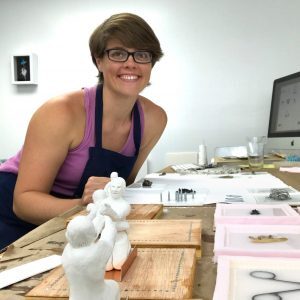 Jenny is a sculptor who explores personal development to connect with others and help them feel their best. Through her blog posts and mixed media sculptures, she invites people into a world of creative trial and error, humor, and inspiration from the heart. Jenny went to The North Carolina School of the Arts in Winston Salem, NC and The Cooper Union in New York City for art school. She likes to introduce herself as a mama and passionate artist who loves to help people feel their best.
Jenny is a sculptor who explores personal development to connect with others and help them feel their best. Through her blog posts and mixed media sculptures, she invites people into a world of creative trial and error, humor, and inspiration from the heart. Jenny went to The North Carolina School of the Arts in Winston Salem, NC and The Cooper Union in New York City for art school. She likes to introduce herself as a mama and passionate artist who loves to help people feel their best.
The post How I Designed My Own Self Guided MFA appeared first on Online Marketing for Artists.
The Abundant Artist Goodreads blog
- Cory Huff's profile
- 31 followers




